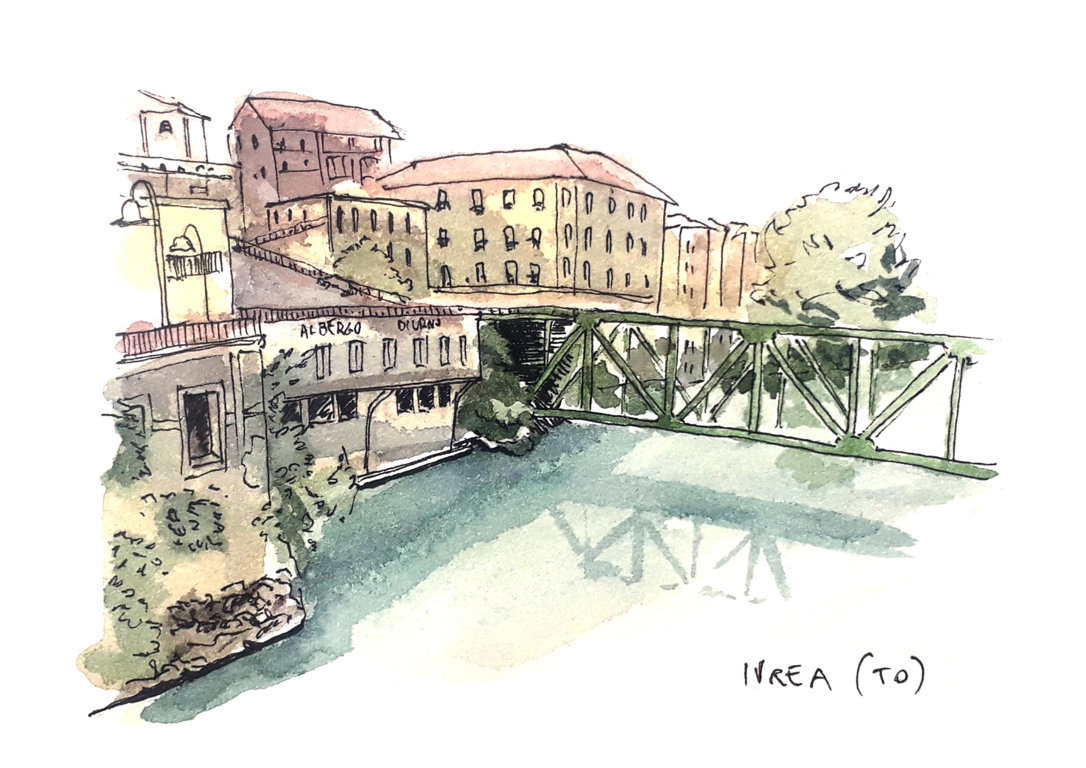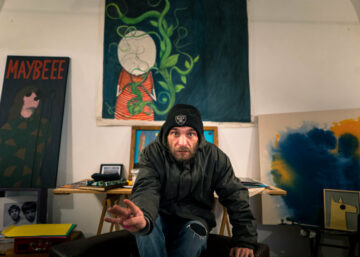Zaino in spalla, taccuino in tasca e un paio di scarpe comode ai piedi. Nell’estate più strana di tutte, quella della pandemia, Valerio Barchi – in arte “Jabòn del Chivo” – decide di percorrere a piedi la Via Francigena con un chiaro obiettivo: farla diventare un fumetto.
È la seconda volta che intraprende questa rotta e, a chiunque gli domandi il perché, risponde laconico: “Per poterla raccontare bene”. Forse una risposta più accurata non esiste perché questa sembra proprio racchiudere in sé tutto il senso della sua avventura.
Ci facciamo quindi narrare da lui stesso questo “pellegrinaggio artistico” lungo la Via Francigena, un viaggio che l’ha portato ad attraversare luoghi simbolo del Canavese come i vigneti di Carema, le Terre Ballerine dei Cinque Laghi e la città di Ivrea.
Ma prima conosciamolo meglio.
“Jabòn del Chivo”: un nome d’arte piuttosto bizzarro. Raccontaci da dove deriva.
Anni fa per mantenermi facevo l’artigiano di strada e, tra i prodotti che proponevo, c’erano saponi all’olio d’oliva. Jabòn del Chivo significa “Sapone del Caprone” in spagnolo (“Chivo” è un omaggio a un personaggio di un film di Inarritu).
Poi smisi di fare saponi e orecchini, e cominciai a disegnare. La pagina Facebook era già creata, dovevo solo cambiare il nome…cosa che non ho mai fatto.
Ora ci sono un po’ affezionato.
Quando e come hai deciso che saresti diventato un fumettista?
L’ho deciso nel 2018, mentre mi trovavo a Taiwan per studiare cinese. Un giorno persi il bancomat e, in attesa che mi arrivasse il sostitutivo, mi misi a dipingere cartoline da vendere in strada. Non avevo mai coltivato il disegno, ma c’ero un po’ portato e le cartoline vendevano benissimo.
Così mi venne l’idea di mettere insieme due desideri che mi ronzavano in testa da un po’: raccontare delle storie e non dover più lavorare per qualcun altro.
Sei un appassionato di fumetti?
Ho letto qualche fumetto principalmente durante i miei vent’anni – Andrea Pazienza, Hugo Pratt, Milo Manara, Dylan Dog – ma non ero un appassionato. Da quando ho cominciato a farne di miei mi è capitato di conoscere più autori e più storie, che apprezzo moltissimo, ma continuo a non definirmi un appassionato di fumetti.
Qual è il personaggio dei fumetti che ti rispecchia di più?
Anni fa avrei sicuramente detto Corto Maltese. È stata certamente un’ispirazione per me, considerando che dai 19 anni ai 30 non ho fatto che viaggiare per il mondo. Poi crescendo mi sono reso conto di assomigliare anche a quei personaggi secondari di Pazienza, quelle comparse supernormali e superordinarie che vengono presi per il culo dall’autore e dal lettore.
Per fortuna una persona del mondo reale è più sfaccettata di un personaggio di un fumetto, quindi in un certo senso si può rivedere anche in personaggi molto diversi tra loro. Tipo il San Francesco reale e il San Francesco di Altan.
Hai una ritualità per disegnare?
Procrastino fino a quando mi disprezzo da solo, poi mi do una mossa.
Da qualche mese vivo e lavoro in un camper. Le comunità di gente che vive in camper (i fulltimer) sono molto brave a passare la giornata solamente a bivaccare, e in questo bivaccare mi ci trovo benissimo. Il che rende tutto più difficile.
Poi mi ricordo che non ho una lira e allora mi metto al lavoro.
Che cos’è la creatività per te?
Non so se sono in grado di rispondere. La cosa più coerente che mi viene in mente è che la creatività non viene da noi, ma ne siamo immersi. Noi siamo dei ricettori di questa creatività. Ognuno a modo suo la recepisce, la rielabora e la canalizza.
Parliamo ora del tuo cammino lungo la Via Francigena.
In cosa è stato differente tornarci a distanza di anni?
Innanzitutto, a livello pragmatico, l’anno. Nell’anno del Covid le strutture ricettive disponibili erano molte di meno, alcune di queste non ce la facevano a tenere aperto a donativo ed era obbligatoria la prenotazione, quindi generalmente parlando è stata una Francigena più cara e frustrante.
La gente era differente. Così come nella quotidianità, anche in cammino si parlava di una cosa soltanto: il Covid.
Ultima cosa, per me la più importante, ero differente io. Nel 2017 l’ho affrontata senza cellulare, senza aspettative, senza obiettivi. È stata un’esperienza che non esito a chiamare mistica.
Quest’anno lo scopo era puramente documentativo. Viaggiare con un fine non è la stessa magia di viaggiare per viaggiare.
Perché l’idea di raccontare il tuo cammino attraverso un fumetto?
Nel 2020 ho pubblicato un fumetto autoprodotto ambientato in una piccola realtà italiana, Ginostra. Avendo viaggiato parecchio in Asia e Australia, mi sono riscoperto attratto dall’Italia di provincia, quella dell’Apecar, delle olive a ottobre e del grappino al baretto.
È questo quello di cui vorrei raccontare il sapore in questo momento.
La Francigena l’avevo già percorsa ed è stata un’esperienza che mi ha segnato. Alla Francigena appartengono tantissime Italie di provincia, tutte legate da un unico filo narrativo. Avevo piacere ad omaggiarla.
Com’è stata l’esperienza di disegnare in viaggio? Meglio seduto ad una scrivania?
Personalmente preferisco la scrivania. Se vedo un bel bosco mi viene di entrarci, contemplarlo, ruzzolarci dentro, non tanto di disegnarlo. Dall’altro lato, quando disegni qualcosa la osservi con un focus diverso da quello della semplice contemplazione: si stabilisce una relazione molto intensa tra disegnatore e soggetto, e questo vale sicuramente anche per i paesaggi.
Un’ultima domanda: quanto Canavese ci sarà tra le pagine del tuo fumetto?
Posso assicurare che il Canavese sarà ben rappresentato nel fumetto: dai vigneti di Carema alle Terre Ballerine dei Cinque Laghi e alla Chiesa della Madonna delle Grazie di Settimo Vittone, fino alla deliziosa Ivrea. Uno specifico quartiere di Ivrea, in particolare, che ci verrà raccontato direttamente da Willy Jervis.
The comic artist on Via Francigena
His backpack on, sketchbook in his pocket and sporting comfortable shoes. In the strangest summer ever, during the pandemic, Valerio Barchi — aka ‘Jabòn del Chivo’ — decided to explore Via Francigena on foot with a clear objective: make it into a comic.
It’s the second time he’s taken this route and, if anyone asks why, he laconically answers: “So I can tell it well”. There might not be a more accurate response because this one seems to fully encompass every sense of his adventure.
So we’ll let him narrate this ‘artistic pilgrimage’ along Via Francigena himself, a journey that led him across Canavese’s most symbolic places like the vineyards of Carema, the Dancing Lands of Cinque Laghi and the city of Ivrea.
But first, let’s get to know him a bit better.
‘Jabòn del Chivo’: a rather bizarre pseudonym. Tell us where you got it from.
Years ago I used to earn a living as a street craftsman and one of the products I offered was olive oil soap. Jabòn del Chivo means ‘Goat Soap’ in Spanish, (‘Chivo’ is an homage to a character out of an Iñárritu film).
Then I stopped making soap and earrings, and started drawing. I already had a Facebook page, I just needed to change the name… but I never got round to it.
And now I’m quite fond of it.
When and how did you decide to become a comic artist?
I decided in 2018, when I was in Taiwan studying Chinese. One day, I lost my bank card and, while I was waiting for a replacement, I started drawing postcards to sell on the street. I’d never studied drawing, but it’s something I’d do, and the postcards sold really well.
So that’s when I got the idea that brought together two of the urges I’d had buzzing around the back of my mind for some time: telling stories and not having to work for somebody else.
Are you a big comics fan?
I’d read some comics, mostly in my twenties – Andrea Pazienza, Hugo Pratt, Milo Manara, Dylan Dog – but I wasn’t a devoted fan. Since I started doing my own, I’ve been finding new authors and new stories, which I really admire, but I still wouldn’t call myself a comic book aficionado.
Which comic book character do you see yourself in the most?
Years ago, I definitely would have said Corto Maltese. He was certainly an inspiration to me, considering that from 19 to 30 years of age I did nothing but travel the world. Then, growing up, I realized I’m also similar to Pazienza’s secondary characters, the ones that seem really normal, really ordinary, that the author and the reader make fun of.
Luckily, people in the real world are more multi-faceted than the ones in comics, so in a certain sense you can also see a range of highly varied characters in them. Like the real Saint Francis of Assisi and the Saint Francis drawn by Altan.
Do you have a drawing ritual?
Procrastinating until I despise myself, then I step up.
I’ve been living and working in a camper van for a few months. The community of people living in campers (the full-timers) are very good at spending time bivouacking, and this bivouacking suits me to a tee. Which makes everything harder.
Then I remember that I don’t have a single penny, and that’s when I get to work.
What does creativity mean to you?
I don’t know if I’m able to answer that. The most consistent thing that comes to mind is that creativity doesn’t come from within us, rather it surrounds us. We’re receptors of this creativity. Each of us, in our own way, receive it and reproduce it and channel it.
Let’s go back to your long journey along Via Francigena.
After coming back after so long what did you find was different?
Above all, on a pragmatic level, this year. In the year of Covid, there was less available accommodation, some facilities weren’t able to stay open with handouts and booking was obligatory, so generally speaking it was a more expensive and frustrating Francigena.
People were different. Just like in day to day life, only one thing was talked about on the road: Covid.
Lastly, and for me the most important thing, I was different too. I went into 2017 with no phone, no expectations, no ambitions. It was an experience I wouldn’t hesitate to call mystic.
This year, the aim was purely documentary. Traveling with an end in sight isn’t as magic as traveling for the sake of traveling.
Why the idea of portraying your journey in a comic?
In 2020 I released a self-published comic book set in a small, real Italian world, Ginostra. Having traveled a great deal in Asia and Australia, I found myself drawn once more to small-town Italy, with its Piaggio Ape cars, October olives, or a drop of schnapps at a little bar.
That’s what I want to illustrate, the taste of that moment.
I’d already walked Francigena and it was an experience that stayed with me. Francigena passes through so many small Italian towns, each linked by one narrative path. I wanted to pay tribute to it.
What was it like drawing on the road? Better sat at a desk?
Personally, I prefer the desk. If I see a beautiful forest I get the urge to go in, roll around in it, not so much to draw it. On the other hand, when you draw something, you look at it with a different focus than simple contemplation: you form a deep drawer-subject relationship, and that definitely goes for landscapes too.
One last question: How many Canavese people are going to be on the pages of your comic book?
I can assure that the people of Canavese will be well represented in the comic book: from the vineyards of Carema to the Dancing Lands of Cinque Laghi and from the Madonna delle Grazie Church to the charming Ivrea. One Ivrea neighborhood in particular, which Willy Jervis will tell us about directly.
CREDITS
Foto e illustrazioni di Valerio Barchi
Articolo di Valentina Ittevilo














